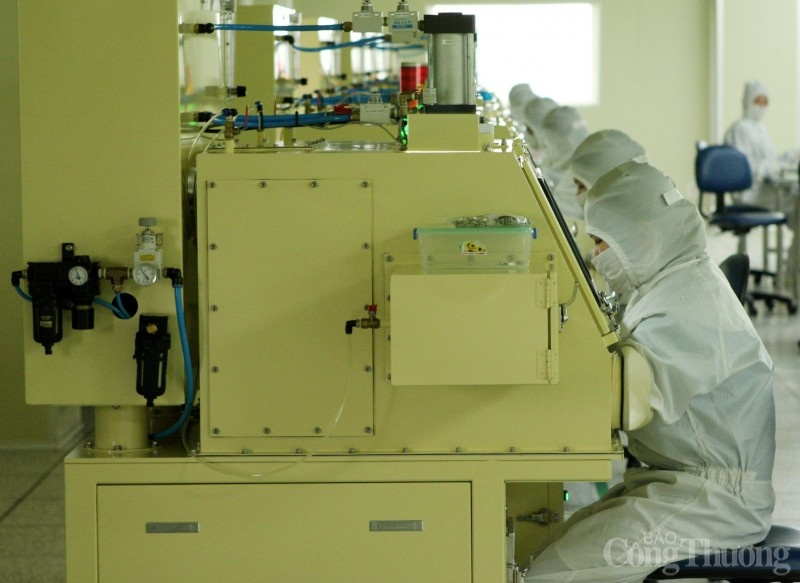According to Gartner – the world’s leading technology consulting and research company, the semiconductor industry is expected to generate over $620 billion in revenue by 2024 and increase to $1 trillion by 2030. This industry is also considered the core part of the technological competition between nations in the 21st century.

Chip manufacturing factory in Vietnam
By participating in the global semiconductor market, Vietnam will have opportunities worth billions of dollars. By 2024, Vietnam’s semiconductor industry is projected to surpass $6.16 billion in value.
The semiconductor industry in Vietnam is emerging as an attractive destination attracting the presence of leading global giants from the US and South Korea such as Intel, Samsung… with projects ranging from hundreds of millions to billions of dollars invested in building factories, expanding production, assembling…
Especially, Vietnam has great potential to develop the semiconductor industry with a young workforce, innovation, and training in related fields.
According to Mr. Nguyen Quan, Chairman of Vietnam Automation Association, former Minister of Science and Technology, Vietnamese people have the capacity, knowledge in information technology, chip technology, and chip design teams in Vietnam have strong research groups.
Minister of Information and Communications Nguyen Manh Hung also affirmed that the fundamental advantage is that Vietnamese people have genes related to STEM (science, technology, engineering, and math). STEM is the basis of semiconductor technology, chip design. Among the advantages, genetic advantage is the most important, certainly not inferior to political advantages. From the labor advantage, other advantages will arise. From being a global human resources center for semiconductors will lead to becoming a global center for the semiconductor industry.
Based on this advantage, Vietnam needs to demonstrate to the world its capacity, human resources of scientific and technological personnel in chips, semiconductors. In the immediate future, strong research groups and chip design groups need to be formed, developed from universities, research institutes cooperating with businesses.
However, from research to testing, achieving international certifications, moving towards commercialization, and chip production is a long and costly journey.
Even if Vietnamese businesses design chips, they do not have enough resources to carry out testing, large-scale production, and commercialization. Therefore, cooperation with foreign technology companies will create favorable conditions for the development of this industry.
Therefore, in addition to preparing internal resources, investment funds for chip research and production, Vietnam needs to make use of international resource support, investment funds from major world companies in this field.
G.S. Teck-Seng Low, Senior Deputy President at the National University of Singapore, revealed that Singapore has copied the semiconductor technology model from Taiwan (China). Singapore does not use much government budget, but this capital is a good bait for the program, attracting leading semiconductor companies to Singapore. Singapore has built policies to attract investors.
“To develop this industry, I think we need to attract foreign investors and develop domestic semiconductor companies. We must combine internal strength and foreign investors,”
– G.S. Teck-Seng Low emphasized, adding that the semiconductor and electronics industry is one of the key industries that helps Singapore gain a good position. Currently, Singapore’s semiconductor industry contributes 9% to the nation’s GDP.
Every year, Singapore spends $5 billion on research, but this amount will be in vain without talented labor resources for development. Therefore, the strategy of attracting talented personnel in the semiconductor field is also a prerequisite factor when you want to truly embark on the development of this technology industry.
Currently, the National Innovation Center (NIC) and three high-tech parks in Ho Chi Minh City, Hanoi, and Da Nang with complete infrastructure are ready to welcome semiconductor investors with high incentives.
NIC and these high-tech parks will be important bridges to support the development of Vietnam’s semiconductor industry ecosystem. NIC, along with foreign and domestic partners, is conducting training and enhancing the quality of human resources in the semiconductor industry for Vietnam, focusing on in-depth training courses in chip design.
In addition, Vietnam has actively prepared conditions to be ready to cooperate with US businesses and investors in the semiconductor supply chain such as: Completing single-window mechanism, building a plan to develop human resources in the semiconductor industry until 2030, reaching 50,000 semiconductor engineers…












